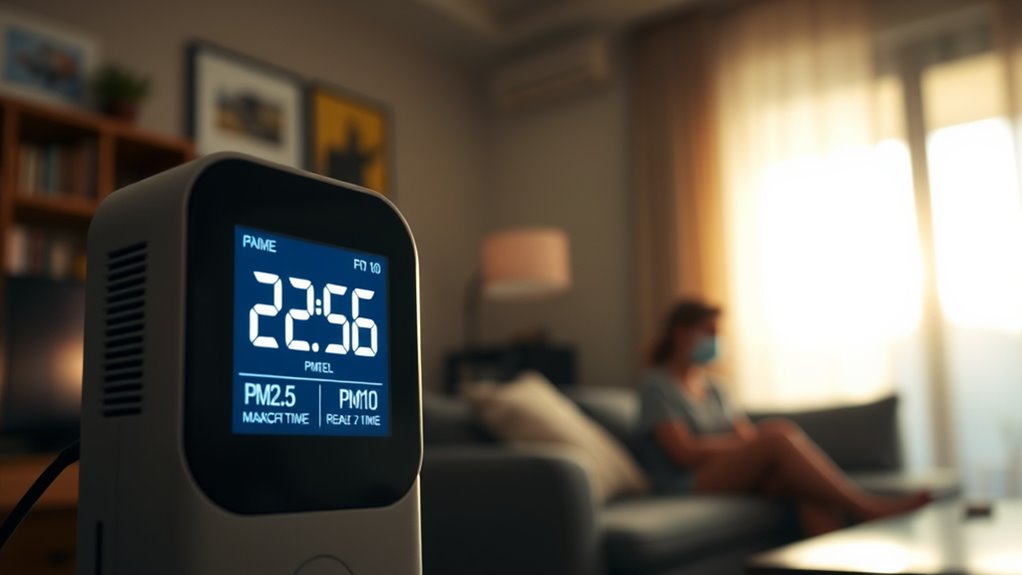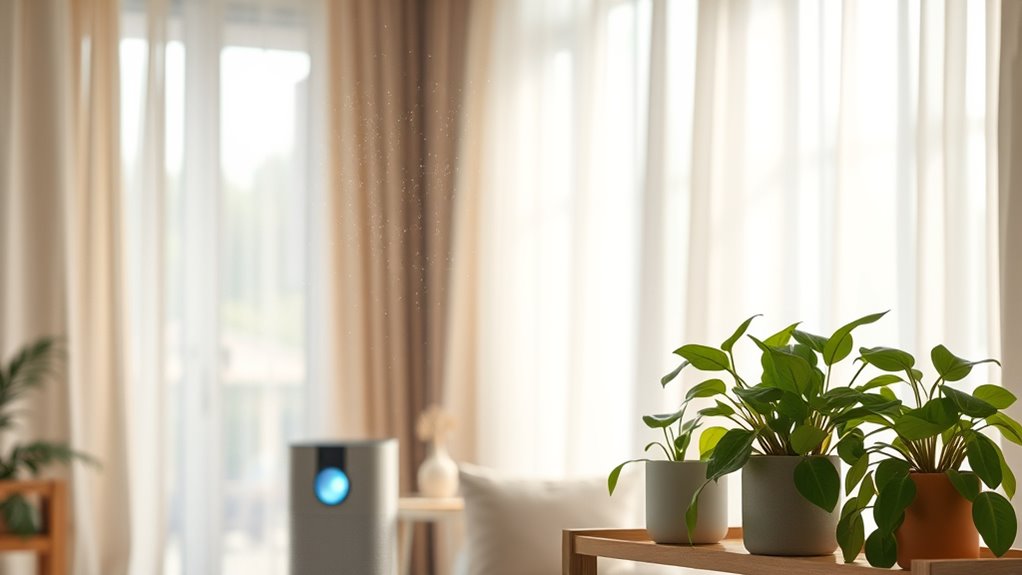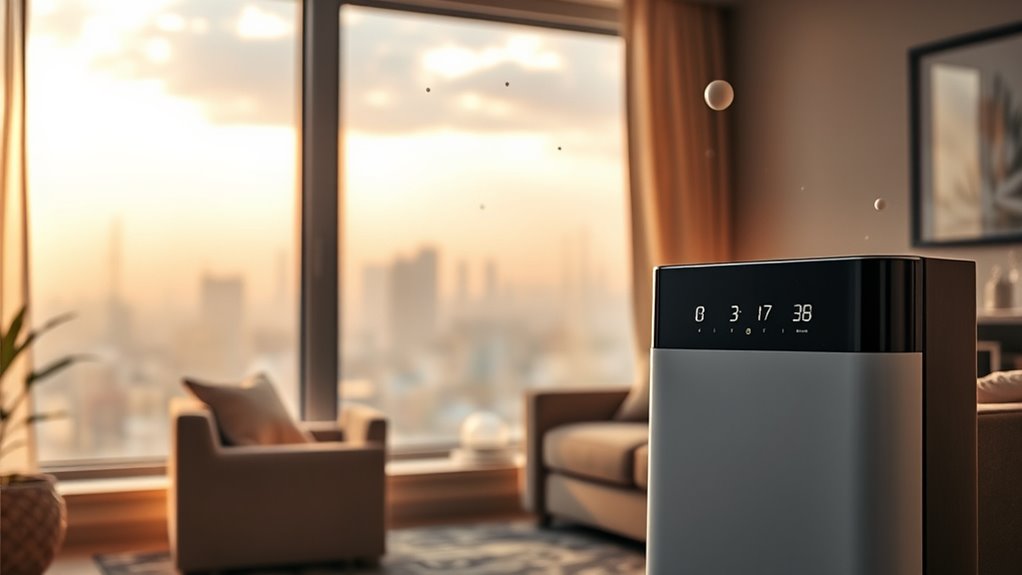PM2.5 particles are tiny, measuring 2.5 micrometers or less, and can penetrate deep into your lungs and bloodstream. PM10 particles are larger, up to 10 micrometers, but still pose health risks. Both impact indoor air quality, with PM2.5 being more dangerous due to its size. Understanding the differences helps you better protect your environment and health. Keep exploring to discover how to effectively manage these particles for a healthier home.
Key Takeaways
- PM2.5 particles are smaller than PM10, penetrating deeper into lungs and bloodstream, posing higher health risks.
- PM10 includes larger particles up to 10 micrometers, affecting upper respiratory pathways more than PM2.5.
- Both types originate from indoor and outdoor sources, but PM2.5 often results from combustion, soot, and organic materials.
- Monitoring and filtering PM2.5 is crucial for better indoor air quality and overall wellness.
- Effective ventilation and HEPA filtration help reduce both PM2.5 and PM10, creating healthier indoor environments.
What Are PM2.5 and PM10 Particles?

Have you ever wondered what exactly PM2.5 and PM10 particles are? These tiny particles vary in particle composition, including dust, soot, smoke, and organic materials. PM2.5 particles are smaller than 2.5 micrometers, while PM10 particles are up to 10 micrometers in diameter. Their small size allows them to penetrate deep into your lungs and even enter your bloodstream. To understand their presence and concentration, scientists use measurement techniques like air sampling and laser particle counters. These methods help determine how many particles are in the air at any given time. Knowing the particle composition and how to measure them is essential for evaluating air quality, especially since these particles can impact your health and indoor environment.
How Do These Particles Affect Indoor Air Quality?

These particles can penetrate deep into your indoor air, affecting air quality more than you might realize. Indoor sources like cooking, smoking, or dust contribute to higher levels of PM2.5 and PM10. Breathing in these particles can increase health risks, especially for sensitive groups.
Particle Penetration Depth
Particles of different sizes penetrate indoor air in distinct ways, directly impacting air quality. Smaller particles, like PM2.5, can easily bypass typical air filtration systems due to their tiny particle size. They penetrate deeper into your respiratory system, reaching the lungs and even entering your bloodstream. Larger particles, such as PM10, tend to be filtered out more easily by standard air filtration devices because their size makes them easier to trap. This difference in penetration depth means that even if your air filters are effective against larger particles, you might still be exposed to harmful PM2.5 particles that get further into your lungs. To improve indoor air quality, focus on high-efficiency filters designed specifically to target these smaller particles and reduce their penetration depth.
Indoor Pollutant Sources
Ever wonder how indoor pollutant sources contribute to air quality issues? Dust from furniture, pet dander, cooking fumes, and tobacco smoke release particles like PM2.5 and PM10 into your indoor air. These tiny particles can accumulate quickly, especially if you neglect air filter maintenance, allowing pollutants to circulate freely. Proper ventilation techniques, such as opening windows or using exhaust fans, help dilute indoor pollutants and improve air quality. Regularly replacing or cleaning air filters ensures they trap more particles and prevent them from recirculating. Keep your home well-ventilated and maintain your air filtration system to reduce indoor pollutant levels. This proactive approach helps you breathe cleaner air and minimizes the buildup of harmful particles indoors.
Health Impact Risks
Since PM2.5 and PM10 are tiny enough to bypass your body’s natural defenses, inhaling them can pose significant health risks. These particles can penetrate deep into your lungs and even enter your bloodstream, increasing the risk of respiratory and cardiovascular issues. Poor air filtration allows these pollutants to accumulate indoors, making your environment more hazardous. Pollutant sources like smoking, cooking, cleaning, and outdoor air infiltration contribute to higher levels of PM. Over time, exposure can lead to asthma, allergies, lung irritation, and more serious conditions such as heart disease. To protect yourself, invest in effective air filtration systems and identify pollutant sources that increase particle concentrations. Reducing indoor PM levels is key to maintaining better health and improving overall indoor air quality.
Health Risks Associated With PM2.5 and PM10 Exposure

Exposure to PM2.5 and PM10 can harm your respiratory system, causing issues like asthma and reduced lung function. It also increases your risk of heart disease over time. Vulnerable groups, such as children and the elderly, face even greater health dangers from these particles.
Respiratory System Impact
Both PM2.5 and PM10 can pose serious health risks when inhaled, especially affecting your respiratory system. These particles can irritate your airways, leading to increased allergy triggers and making you more prone to respiratory infections. PM2.5 particles are small enough to penetrate deep into your lungs, causing inflammation and impairing lung function over time. PM10 particles, while larger, still irritate your nasal passages and bronchi, worsening asthma symptoms and other respiratory conditions. Continuous exposure can weaken your respiratory defenses, making it harder to fight off infections. If you already have allergies or asthma, these particles can intensify your symptoms. Protecting yourself from inhaling these particles is essential to maintaining healthy lungs and avoiding long-term respiratory issues.
Heart Disease Risks
Inhaling PM2.5 and PM10 doesn’t just affect your lungs; it also considerably increases your risk of heart disease. Fine particles can enter your bloodstream, causing inflammation and arterial damage over time. To reduce this risk, focus on air purifier selection—choose models with HEPA filters that effectively trap these particles. Proper ventilation techniques are equally important; make certain your home is well-ventilated to remove airborne pollutants. Regularly airing out your space and using exhaust fans can help dilute indoor PM levels. Combining these strategies minimizes your exposure, supporting better heart health. Remember, small adjustments in your home environment can have a significant impact on your cardiovascular well-being. Stay proactive about air quality to protect your heart from the dangers of PM2.5 and PM10.
Vulnerable Populations
Who faces the greatest health risks from PM2.5 and PM10 pollution? Vulnerable populations, including children, the elderly, and those with pre-existing health conditions, are most at risk. These groups have weaker immune defenses and are more sensitive to airborne pollutants. Exposure can worsen respiratory issues, trigger asthma attacks, and increase cardiovascular problems. To protect yourself and loved ones, investing in effective air filtration is essential—especially in homes and living spaces. Air purifiers equipped with HEPA filters can markedly reduce particulate matter indoors. By understanding your vulnerability and improving indoor air quality, you can lower health risks associated with PM2.5 and PM10 exposure, creating a safer environment for everyone in your household.
Sources of PM2.5 and PM10 in Residential Settings

Many common activities and household items contribute to the presence of PM2.5 and PM10 particles in residential environments. Outdoor sources like vehicle emissions, industrial pollution, and pollen can enter your home, adding to indoor particle levels. Household activities such as cooking, cleaning, and burning candles release fine particles into the air. Using fireplaces or space heaters can generate combustion byproducts that increase particulate matter. Additionally, smoking indoors introduces significant amounts of PM2.5 and PM10, impacting air quality. Dust from carpets, furniture, and textiles also contributes to indoor particle levels. While some outdoor sources are beyond your control, understanding how everyday household activities add to particulate matter helps you recognize potential sources and take steps to minimize your exposure.
Effective Strategies to Reduce Particulate Matter at Home

To effectively reduce particulate matter at home, start by improving ventilation to remove indoor pollutants and bring in cleaner air. Proper ventilation strategies help lower PM2.5 and PM10 levels, making your indoor environment healthier. Use air quality monitoring devices to identify pollution hotspots and track your progress over time. These devices provide real-time data, helping you adjust your ventilation efforts accordingly. Open windows when outdoor air quality is good, and consider exhaust fans in kitchens and bathrooms to evacuate airborne particles. Regularly maintain HVAC systems and air filters to ensure they operate efficiently. By combining vigilant air quality monitoring with smart ventilation strategies, you create a safer, cleaner indoor space that minimizes particulate matter and supports your overall wellness.
Choosing the Right Air Purification Methods

Choosing the right air purification method is essential for effectively reducing PM2.5 and PM10 levels in your home. Start by exploring different air purifier types, such as HEPA filters, activated carbon filters, or UV sterilizers, each designed to target specific pollutants. HEPA filters are highly effective at capturing tiny particles like PM2.5 and PM10 due to their advanced filtration technologies. Activated carbon filters help remove odors and harmful gases, complementing particle filtration. UV sterilizers can kill bacteria and viruses, providing an added layer of protection. When selecting an air purifier, consider your specific needs, room size, and pollutant sources. Opt for models with certified filtration technologies that guarantee high efficiency in removing fine and coarse particulate matter, ensuring a healthier indoor environment.
Frequently Asked Questions
How Can I Accurately Measure Indoor PM2.5 and PM10 Levels?
To accurately measure indoor PM2.5 and PM10 levels, you should use air quality sensors designed for fine particulates. Guarantee the sensors are properly calibrated and placed in representative areas. Rely on reliable sampling methods, like continuous monitoring or periodic air sampling, to get precise readings. Regularly check sensor performance and maintain them to ensure you’re getting accurate data, helping you manage your indoor air quality effectively.
Are There Specific Air Purifiers That Target Both PM2.5 and PM10 Effectively?
Yes, there are air purifiers designed to target both PM2.5 and PM10 effectively. Look for models with advanced air purifier technologies, such as HEPA filters, which excel at particulate matter filtration. These purifiers can capture both fine and coarse particles, improving your indoor air quality. Make sure to choose one with a high CADR rating for better efficiency, and keep filters maintained for peak performance.
Do Humidity Levels Influence the Concentration of Particulate Matter Indoors?
Humidity helps or hinders how particles hover and settle indoors. When humidity levels are high, particles like Pm2.5 and Pm10 can cling together, creating more polluted air. Low humidity can dry out air, making particles stay airborne longer. To combat this, you should focus on effective indoor air circulation and ventilation strategies. Proper ventilation clears out pollutants, while controlling humidity keeps particles in check and improves overall air quality.
Can Plants Help Reduce PM2.5 and PM10 Indoors Naturally?
Plants can help reduce PM2.5 and PM10 indoors through natural filtration, offering some air quality benefits. Their leaves trap particles and absorb pollutants, making your space healthier. However, don’t rely solely on plants for significant air purification; they work best alongside proper ventilation and air purifiers. Incorporate plants for their aesthetic and air-cleaning benefits, but remember they’re just one part of a broader approach to improving indoor air quality.
What Are the Long-Term Health Effects of Low-Level, Chronic Particulate Matter Exposure?
Think of chronic particulate matter exposure as slowly wearing down a sturdy wall. Over time, even low-level pollution can lead to serious health issues, increasing your risk of chronic respiratory problems and cardiovascular risks. Long-term exposure wears down your immune defenses, making you more vulnerable to illnesses. To protect yourself, minimize indoor pollutants and stay vigilant about air quality, because even tiny particles can cause big health problems down the line.
Conclusion
Knowing the difference between PM2.5 and PM10 helps you make smarter choices for your home’s air quality. Don’t let the idea of expensive filters discourage you—simple steps like regular cleaning and proper ventilation make a big impact. You don’t need to be an expert to improve your wellness. Just start small, stay consistent, and breathe easier every day. Your health and comfort are worth it—so why not take control today?









